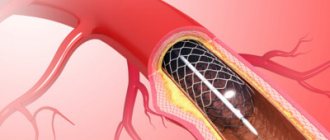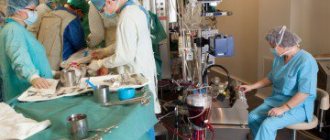Heart bypass surgery is performed quite often. This is due, first of all, to the increase in the number of patients suffering from problems with the blood supply to the heart muscle and the effectiveness of this treatment method. This type of surgery gives a high chance of a full life in the future and reduces the risk of myocardial infarction. However, questions arise as to whether the patient will be able to work in the same place after bypass surgery, what complications are possible, and whether they give disability after bypass surgery of the heart vessels. Let's consider these questions.
Complications arising from heart bypass surgery
Almost every surgical procedure carries a risk of complications for the patient, especially heart surgery.
Despite the positive dynamics of coronary artery bypass grafting (CABG), patients may experience the following complications:
- bleeding in the area of the surgical wound;
- bleeding and infection of the wound at the site of the vein incision (usually the thigh area);
- dysfunction of the shunt due to its narrowing;
- opening of seams;
- pain and heat in the chest area;
- deterioration of cognitive processes;
- thrombosis of venous beds;
- the appearance of angina attacks;
- impaired blood supply to the brain;
- general weakness of the body.
To eliminate the possibility of complications, you must adhere to strict rules for the postoperative recovery period given by your doctor.
Heart bypass surgery - disability after surgery
Many patients who undergo surgery believe that they will develop disabilities and limitations in their physical abilities in the future. However, the disability group is assigned to only 7-8% of patients. In most cases (85%) they are given temporary disability (6-12 months) with the assignment of a third disability group.
To obtain a disability group, the patient undergoes a medical commission. To make a decision, the commission takes into account the following factors:
- patient's age;
- heart disease before surgery;
- the presence of chronic diseases, heart failure;
- high risk of heart attack;
- state of the body before and after surgery;
- serious thinking problems and memory impairment.
The first disability group is assigned to patients under the following circumstances:
- angina pectoris with frequent attacks (several times a day);
- symptoms of chronic heart failure;
- severe heart rhythm disturbances.
The second group is assigned in the following cases:
- increasing heart failure;
- daily attacks of angina.
Disability after coronary artery bypass grafting of the third group is assigned when:
- periodic attacks of angina pectoris;
- moderate cardiac dysfunction;
- constant general malaise;
- disruption of memory and thinking processes.
Only if there are several symptoms after bypass surgery, a person will be given disability group 1, 2 or 3.
How long is sick leave given after surgery?
The first case of abdominal surgery is the most complex and requires long-term hospital stay, so the attending physician himself can issue a medical document for a long time. The second type is less traumatic for humans. It involves punctures with special instruments, after which the body is able to quickly recover, so the period of stay in the hospital is 15 days.
This is interesting: Sample application for free school meals for large families
The maximum period of illness cannot be determined unambiguously; it all depends on the complexity of the operation itself and the speed of restoration of human health. All of the above cases of meeting with a surgeon must be paid for by the employer in accordance with the law.
Where disabled people do not work
Having a disability group, a person works with certain restrictions. Of course, it is necessary to take into account the patient’s profession and work schedule.
Like any other employee of the organization, a disabled person cannot be limited in labor rights.
After heart bypass surgery, a person is given a disability group, and he will not be able to work in hazardous industries, on night shifts or daily work, unload cargo or lift heavy objects. Restrictions also apply to military service and work in the police department.
It is possible to reach agreement with the employer on the work schedule and duration of work. However, disability relief does not apply to the quality of work performed.
Coronary artery bypass surgery: is it worth doing?
I paid the company on September 10, 2012. From September 27, 2012, I opened a sick leave certificate until November 18, 2012. On October 19, I submitted my sick leave to the human resources department at my last place of work. They didn’t give me any application forms to pay for the bill; they told me to call the accounting department after November 5, 2012, after which they would tell me when to come and fill out the application. Please tell me whether there are deadlines for payment of bills according to the law or is it all at the discretion of the enterprise administration?
Please note => How to obtain or buy Russian citizenship for a Moldovan
What opportunities/benefits do disability groups provide?
Disability groups mean receiving preferential pensions and paying benefits.
Third group
Disability groups mean receiving preferential pensions and paying benefits.
At the same time, the third disability group provides the following benefits:
- discounts on public transport;
- discounts on medical care, purchase of medical equipment and medicines;
- preferential sanatorium-resort treatment;
- benefits regarding tax payments;
- benefits for housing and communal services;
- employment with a part-time schedule;
- the right to independently choose the time of vacation.
Second group
The second disability group provides the following benefits:
- free travel on public transport;
- provision of medications prescribed by a doctor;
- preferential sanatorium-resort treatment;
- provision of medical equipment;
- dental prosthetics;
- the right of priority admission to educational institutions of higher and secondary education;
- right to an increased scholarship;
- a working week shortened to 35 hours for a working disabled person of the second group;
- receiving vacation up to 60 days;
- exemption from property tax inherited;
- other tax breaks.
First group
People with the first disability group enjoy the following benefits:
- free travel on public transport;
- free medicines, medical equipment and dressings prescribed by a doctor;
- free sanatorium-resort treatment and recreation once a year for 3 years from the date of receipt of the group;
- free prosthetics, incl. and dental;
- free orthopedic shoes;
- extraordinary admission to educational institutions of higher and secondary education;
- increased scholarships;
- for working disabled people a shortened working week of up to 35 hours;
- receiving vacation up to 60 days;
- exemption from property tax inherited;
- other tax breaks.
The procedure for registering a disability group according to the heart
To begin with, a person after CABG is contacted by a cardiologist to receive a package note, a referral for tests and instrumental examination.
Next, the patient makes a round to the required doctors, takes tests and undergoes an examination.
To receive a group, the patient needs:
- perform a complete examination of the cardiovascular system;
- perform an examination to identify other systemic diseases;
- go to your doctor with the results and get a referral to a commission;
- undergo a medical and social examination, a medical commission, which will determine the rationale for assigning a particular disability group and set the terms of disability.
The following list of documents is also prepared:
- a copy of the work record, if the person worked before the operation;
- passport;
- outpatient card;
- patient's application for examination;
- certified epicrises from hospitals.
Next, a meeting of the medical commission takes place and a conclusion is made. If a disability group is assigned, the person is given the necessary certificates and a rehabilitation program.
If the patient does not agree with the decision, it is appealed to a higher commission or through the court.
Algorithm for obtaining disability
- Undergo a full examination of the cardiovascular system.
- Get tested for other systemic diseases. except for coronary heart disease.
- Provide examination results to the attending physician who refers you to the commission.
- Pass a medical and social examination, a medical commission. Here the rationale for registration of a particular group is determined, the duration of disability is established (six months, a year, two, lifelong).
Thus, if there are undeniable medical indications indicating incomplete recovery and restoration of the patient, after heart bypass surgery a disability is issued. The disability group is determined based on the severity of the disease. In case of full rehabilitation and the opportunity to continue working, the application for disabled status will be denied.
Every citizen of the Russian Federation or resident of the country has the right to receive medical care. In addition to treatment, workers also receive sick leave, which allows them to claim payment for days of incapacity for work. A sick leave, in addition to financial compensation, provides the patient with a basis for temporarily not attending his workplace on legal grounds. During the period of illness, the worker retains his position and salary.
A sick leave certificate is an official document that is issued only in those medical institutions that have special accreditation. For this reason, a disability form can only be obtained by visiting a doctor; when calling an ambulance or a doctor at home, its discharge is impossible. A certificate of incapacity for work is a special document that has a unique barcode and many degrees of protection. This procedure helps prevent forgery of documents.
Medical and social examination
Coronary artery bypass grafting
CABG is a surgical intervention to perform operations on the vessels of the heart in order to restore blood flow in the coronary bed.
One of the main indications for surgery is coronary heart disease. Additional indications for performing CABG on a patient:
- persistent manifestations of angina pectoris that cannot be corrected by drug treatment;
- significant narrowing of the coronary bed;
- high risk of myocardial infarction.
In the classic version, coronary artery bypass surgery is a rather complex and dangerous surgical intervention for the patient, consisting of the following main stages:
- To begin with, the patient is subjected to general anesthesia.
- Next, the chest is opened using a median sternotomy.
- The pericardial cavity is opened, and in parallel with the process, a vessel is taken, which will later be used as a shunt.
- After a series of measures, the heart is connected to a heart-lung machine;
- Next, a shunt is applied and the heart is removed from the artificial blood supply and, under the conditions of a contracting organ, the aorta and interventricular artery are connected by a shunt.
- The blood supply to the myocardium is restored, the chest is sutured.
Disability after cardiac bypass surgery
Having undergone heart bypass surgery is not a mandatory reason for being declared disabled. CABG allows the heart to restore function and the patient to return to their normal lifestyle.
If after the operation the heart function is restored, ultrasound reveals no abnormalities or they are insignificant, and the patient’s condition is good, the person is not considered disabled. However, bypass surgery is a reason to prescribe a medical rehabilitation commission (MREC), which includes an examination by expert doctors headed by the chairman.
The commission analyzes the medical history, examination results, and the patient’s condition and makes a decision on the presence or absence of symptoms indicating disability. If there are pronounced disturbances in the functioning of the cardiovascular system, difficulties in carrying out work activities and performing the necessary actions for self-care, a person is assigned a disability group. In case of persistent and irreversible changes in the functioning of the heart and the age of the patient (in women over 55 years old, in men over 60 years old), a lifelong group may be assigned. But this happens quite rarely.
Grounds and procedure for issuing sick leave after a heart attack, stenting and bypass surgery
Myocardial infarction is an acute condition that threatens not only the health of the patient, but also his life, therefore, any person who applies to a licensed medical institution for medical care has the right to issue a sick leave certificate and receive temporary disability benefits if he is insured in system of compulsory health insurance and is an employee in the sense provided for by the Labor Code of the Russian Federation.
The basis for extending sick leave is the need for long-term rehabilitation , which requires rest, as well as the serious condition of the patient after a heart attack or related invasive procedures, due to which he cannot perform his work duties. According to the Federal Law “On the Fundamentals of Protecting the Health of Citizens in the Russian Federation” dated November 21, 2011 No. 323-FZ, with an obvious unfavorable prognosis, the patient is sent to undergo an examination and receive disability.










